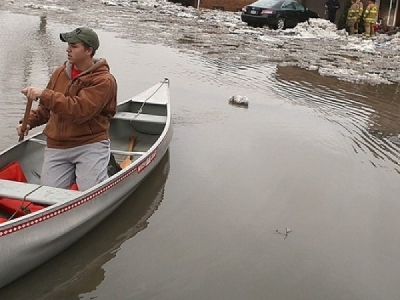
Posted on July 12, 2016
By Joseph Popiolkowski, The Buffalo News
When ice jammed Buffalo Creek in January 2014, about 70 homes in West Seneca’s Lexington Green neighborhood were flooded.
Dave Monolopolus remembers losing $25,000 worth of possessions, including a riding lawn mower, hot water tank and 30 cords of firewood to heat his home.
“We lost everything that was down in our basement,” he said.
After the floodwaters receded, residents and local officials called on the federal government to develop a plan to prevent it from happening again.
But two years later, the U.S. Army Corps of Engineers has decided not to continue with a flood risk management study of Lexington Green.
“The costs to implement a project would be greater than the economic benefits achieved,” according to the Army Corps. “Therefore, a study will not be pursued.”
The Army Corps completed a preliminary study called a “federal interest determination” last winter and held a public meeting on the findings Thursday in the courtroom at Town Hall, 1250 Union Road. The Army Corps conducted the preliminary study at the request of the town and with financial support from Sen. Charles E. Schumer. The 62-page report is available on the town’s website, westseneca.net.
“Knowing they’re not going to put anything into practice is unfortunate,” said Town Supervisor Sheila M. Meegan. “But at the same time, the study is what it is and we have to obviously accept the report.”
The neighborhood located between Mineral Springs Road to the south and Buffalo Creek to the north and east in 2014 experienced two flood events within six weeks.
The last flood in that area had occurred in 1979. An Army Corps study following that flood looked at six measures to alleviate flooding, but none ever was implemented.
On Jan. 11, 2014, the water level in Buffalo Creek rose rapidly, increasing by approximately 4 feet in 1½ hours and approximately 4½ feet in 2½ hours, according to the Army Corps study. Water exceeded the banks and flooded low areas and roads first, causing water to back up into basements. Damage was done to first floors as well.
The second flood event occurred Feb. 21, 2014, when water once again rose rapidly to reach major flood stage and receded rapidly as well, returning to below flood levels in approximately an hour.
“They said it was a 100-year flood and it happened twice in a month,” Meegan said. “Hopefully, it doesn’t happen again for 200 years.”
Damage from the flooding was estimated at nearly $1.2 million. Repairing and replacing drywall, carpets, furnaces and appliances were the leading damage-related costs, according to the Army Corps. The households with the highest reported damage also indicated foundation and automobile damage. The town also incurred more than $322,000 in costs related to the floods.
The Army Corps in its federal interest determination looked at four possible measures to address future flooding of Buffalo Creek.
Three structural measures included construction of a levee at an estimated cost of $5.3 million, a flood bench for $8.7 million or an ice control structure for $13.2 million. One non-structural measure – a flood early warning system – was considered at an estimated cost of $107,429.
The ice control structure would be similar to the steel and concrete pylons installed in nearby Cazenovia Creek but would need to also include the flood bench, a channel along the creek’s north bank designed to handle high flow.
“The flood bench would provide the increased flow area needed to accommodate flow around the ice control structure during an ice jam event,” according to the preliminary report.
Any measure must pass tests of engineering feasibility, environmental acceptability and economic justification to be implemented, said David Schulenberg, chief of the Army Corps planning branch.
“We looked at the costs and we looked at the benefits,” he said. “And really it comes down to, from a federal investment point of view, the benefits don’t outweigh the costs.”
Cost-benefit ratios of 0.25 for the levee, 0.15 for the bench and 0.10 for the ice control structure were calculated. The ratios compare the average annual estimated damages likely to be prevented to the costs of implementation over a 50-year period.
“In short, you would need a minimum of a 1.0 benefit-cost ratio, which means that costs would equal benefits over a 50-year period in order for us to seek additional federal resources to implement a project,” Schulenberg said.
He said he understands residents may be disappointed in the outcome, but that the Army Corps will continue to coordinate with local and state officials on “smaller-scale efforts,” including flood preparation, flood preparedness plans, technical advice and emergency response.
The town will also continue enhancing its own initiatives, Meegan said, including sand bags, an alarm system and valve, CodeRED emergency alerts and a berm between the creek and homes. The town will also continue working with the state Department of Environmental Conservation to clean up the creek’s shoals to help keep water moving, she said.
“The facts are what they are,” she said. “The findings are what they are and we will go forward and do what we can as a municipality to reassure those residents that any resources we have will be put in play as necessary.”
Source: The Buffalo News





